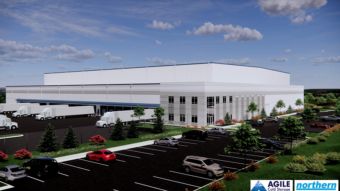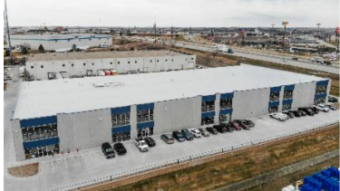The University of Chicago‘s William Eckhardt Research Center, designed by HOK, was formally dedicated on Oct. 29 on the university’s main campus south of downtown Chicago–a month after its opening.
The center, named after alumnus William Eckhardt, combines the university’s first molecular engineering program and its Nobel Prize-winning physical sciences research groups. It includes state-of-the-art laboratories, offices, conference rooms, a 150-seat conference facility and a café.
Eckhardt graduated in the 70s and is recognized for his generous support of the Physical Sciences Division and the university.
“The Institute for Molecular Engineering has been successful in building a new model for molecular-level research with broad impact, and this facility will allow for even more ambitious work,” University of Chicago Provost, Eric Isaacs, said. “Equally significant, this building befits the Department of Astronomy and Astrophysics’ long tradition of scientific eminence, and its continuing importance in that field of study.”
The center is home to the university’s Department of Astronomy and Astrophysics, the Kavli Institute for Cosmological Physics, the Institute for Molecular Engineering and the Dean’s Office of Physical Sciences.
Conducting research in this building are world-leading research teams working across multiple disciplines in the fields of chemical, electrical, mechanical and biological engineering as well as the traditional materials and physical sciences.
Five floors above grade provide flexibility and infrastructure for a variety of different lab types ranging from optics to chemistry. To isolate highly specialized labs including the Pritzker Nanofabrication Facility cleanroom and a high bay assembly lab from vibration and electromagnetic interference, two of the center’s seven floors are below grade.
“The University of Chicago scientists and engineers who participated in the design process emphasized to us that, in addition to creating opportunities for formal collaboration, chance interactions and the ability for researchers, faculty and students to have conversations in informal settings are invaluable,” Mickey Collins, AIA, LEED AP, HOK’s project manager said. “Our team designed every aspect of the Eckhardt Research Center to foster the type of interdisciplinary collaboration required to generate scientific breakthroughs.”
Carefully planned interaction spaces include a large conference facility, pre- and post-event space, a café, light-filled hallways and highly coveted corner collaboration areas with open views. Each floor is considered a neighborhood, with a home base at the north end providing the largest gathering spaces. On the building’s top floor, an open balcony provides a view of the Chicago skyline to the north.
The design links people to nature and light. James Carpenter Design Associates (JCDA) collaborated as a design consultant to HOK in the creation of the dynamic building enclosure. JCDA’s design of the envelope is based on revealing light as a powerful and deep expression of nature. Each facade is uniquely responsive to the site and its public realm, harnessing light as an organizing principle for the building’s performance and human experience. The design integrates light within the building’s thresholds and public circulation spaces, where it resonates with and informs students’ and researchers’ creativity, discovery, collaboration and exchange of ideas.
To support the center’s mission to drive the research and development of renewable and environmental resources, sustainability is integrated into the building. The facility is expected to achieve LEED Silver certification.




